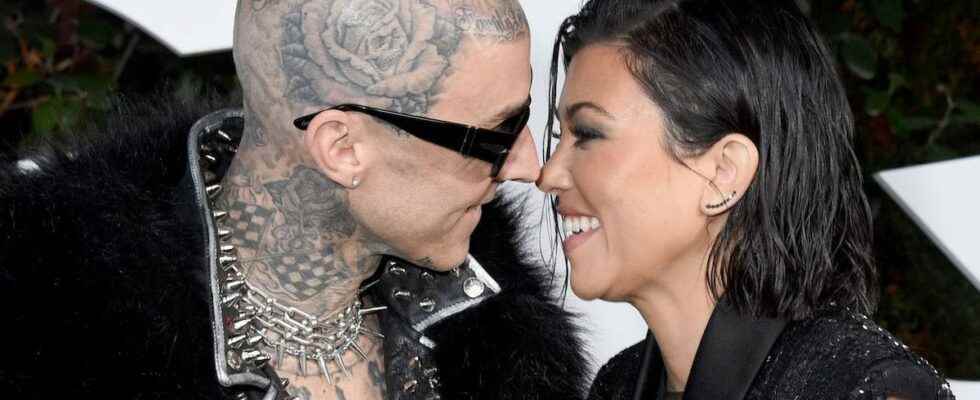Published on
Updated
Reading 3 mins.
Kourtney Kardashian’s husband, Travis Barker, opened up about the fight he’s been fighting with his wife for several months to have a newborn baby.
Already a mother of 3 children – (Mason, 12, Penelope, 10 and Reign, 7), Kourtney Kardashian wants to give birth again. A process that seems a little more complex than expected, if we are to believe the confidences of her husband, interviewed by the American magazine GQ.
The couple faces many difficulties to give birth
In this interview, Travis Barker talks about this fight he leads with his partner to welcome an infant and the importance of showing their journey on the screen.
“I don’t care if I cum in a cup. It’s real life. Seeing Kourtney’s journey through IVF, which is very difficult for a woman, can help people. You’ve seen her fight and talk about it. It’s real. There are several million guys who have to donate their sperm the same way I do. So we can identify, you know? I’ve never been scared of it all“, he confided.
For her part, the 43-year-old businesswoman is particularly worried about the situation.
“She feels that she is reaching an age where it will no longer be possible for her to give birth, so this is almost her last chance. They pray for a miracle“, said a source to USWeekly.
The star would indeed resent the fertility treatment she takes – which would have greatly accelerated her menopause.
“I know it’s helped a lot of people, but it’s just not for me. It really impacted my health, even mentally, hormones, medications.”
Even if the couple does not lose hope, the mother confides “to have stopped” IVF for the moment.
“We’re done with IVF so far and we’re repeating prayers and hoping that God blesses us with a baby.”.
NO to diets, YES to WW!
The different stages of IVF
As stated by the Biomedicine Agencyin vitro fertilization takes place in several stages.
- Stimulation is a hormonal treatment administered by injection, making it possible to obtain the simultaneous development of several follicles, and to be able to collect oocytes before ovulation. The treatment is adapted according to ultrasounds and hormonal assays. When the follicles are mature, ovulation is triggered at a specific time, which makes it possible to determine the time of the follicular puncture.
- Follicular puncture is performed vaginally under ultrasound control and under general or local anesthesia. e or local.
- After the puncture, the follicular fluids containing the oocytes are transmitted to the laboratory. The sperm is collected by masturbation, in the laboratory, and prepared on site the day of the puncture (in special situations, previously frozen sperm will be used).
- The prepared spermatozoa are simply placed in contact with the oocytes in a culture dish containing a liquid nutrient medium and placed in an incubator at 37° C. The mobile spermatozoa come spontaneously, without outside help, into contact with the oocyte. Only one sperm will fertilize this one.
- The day after the puncture, the fertilized oocytes (or zygotes) are identifiable by the presence of 2 nuclei, called pronuclei: one comes from the oocyte the other from the spermatozoon. Not all oocytes are necessarily fertilized. Zygotes become two to four cell embryos in 24 hours, then six to eight cells 24 hours later. In the majority of cases, the embryos are transferred two to three days after the puncture.
- Embryo transfer is a simple and painless gesture that is sometimes performed under ultrasound control. It is performed using a thin, flexible catheter introduced vaginally into the uterus, with the patient lying in a gynecological position. The embryo is deposited inside the uterus and develops there until it is implanted.
- The number of embryos obtained may be greater than the number of embryos transferred. In this case, the so-called “supernumerary” non-transferred embryos which present satisfactory development criteria can be frozen. These embryos, after thawing, can be placed in the woman’s uterus at a later date without it being necessary to perform a new IVF procedure.
The storage of these embryos can last several years. On this subject, an American couple has just given birth to twins whose embryos had been frozen for thirty years.
